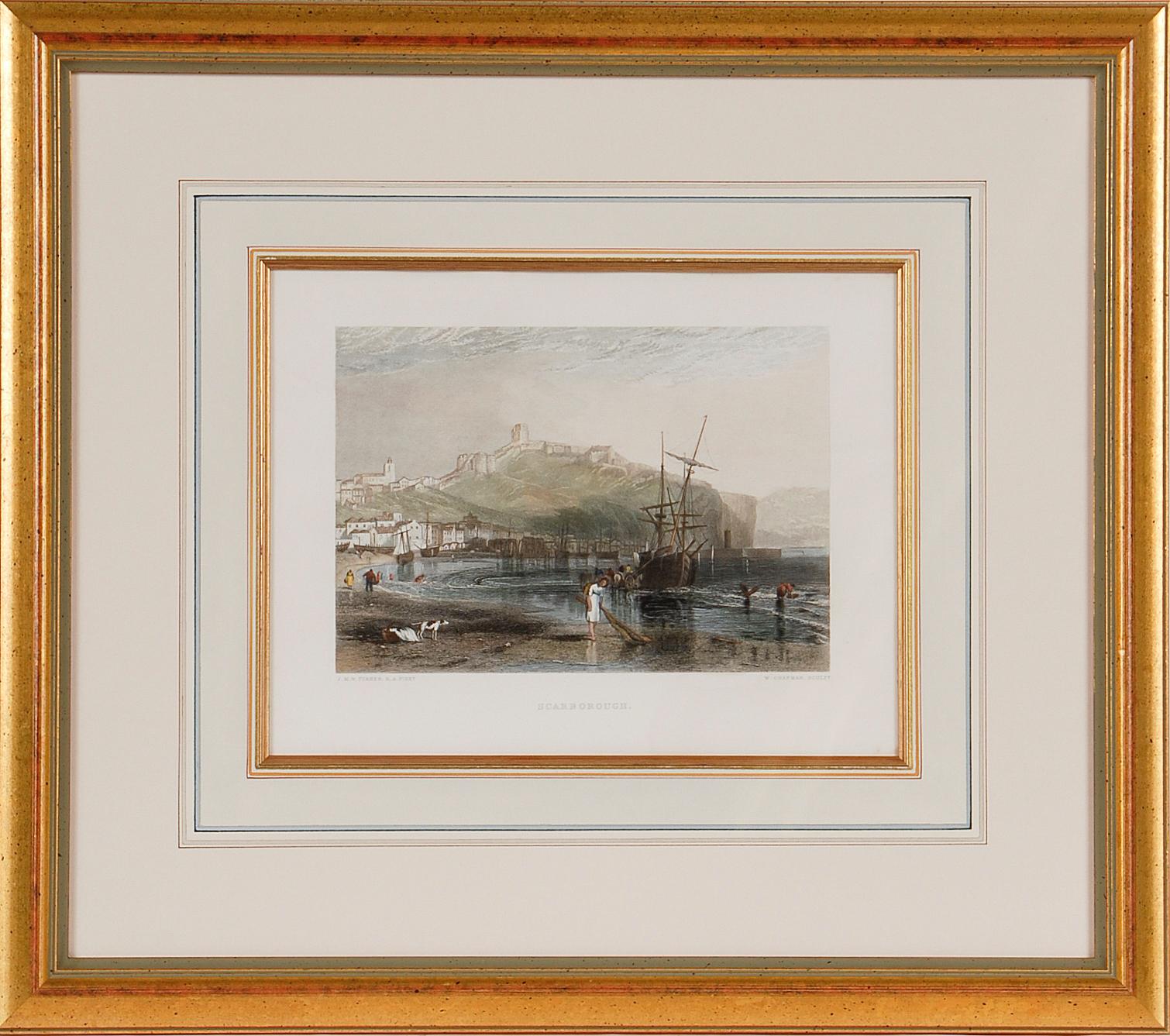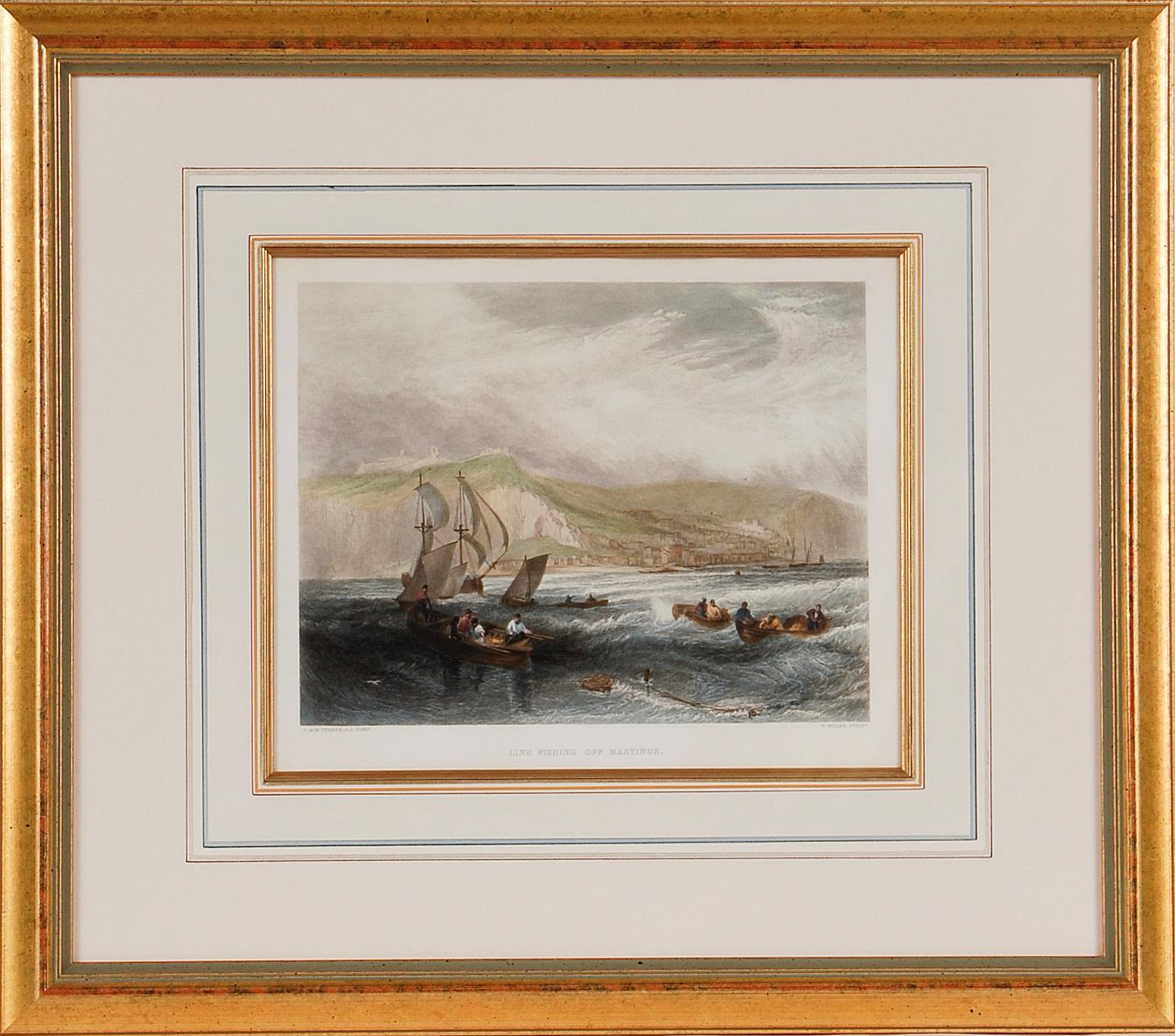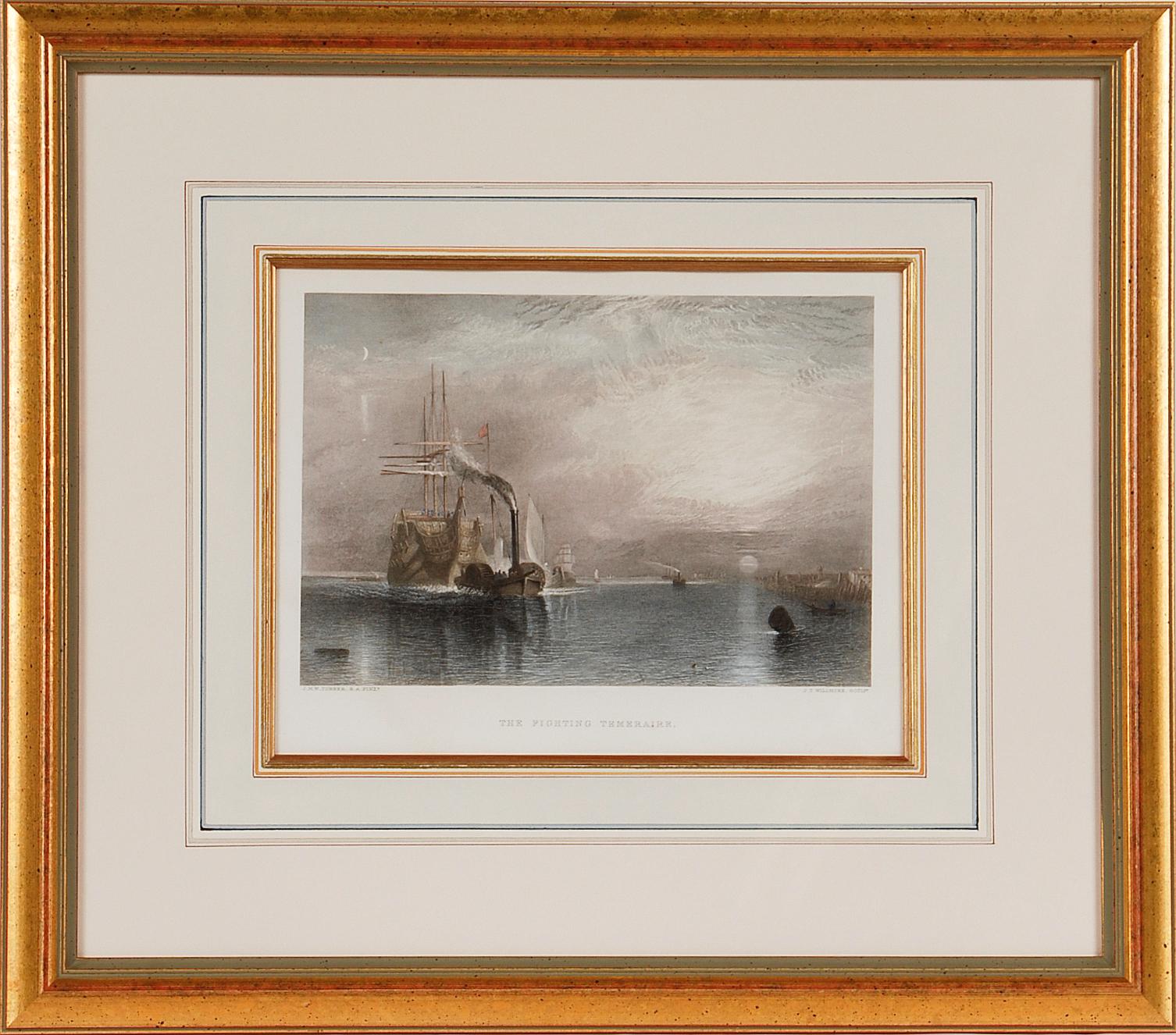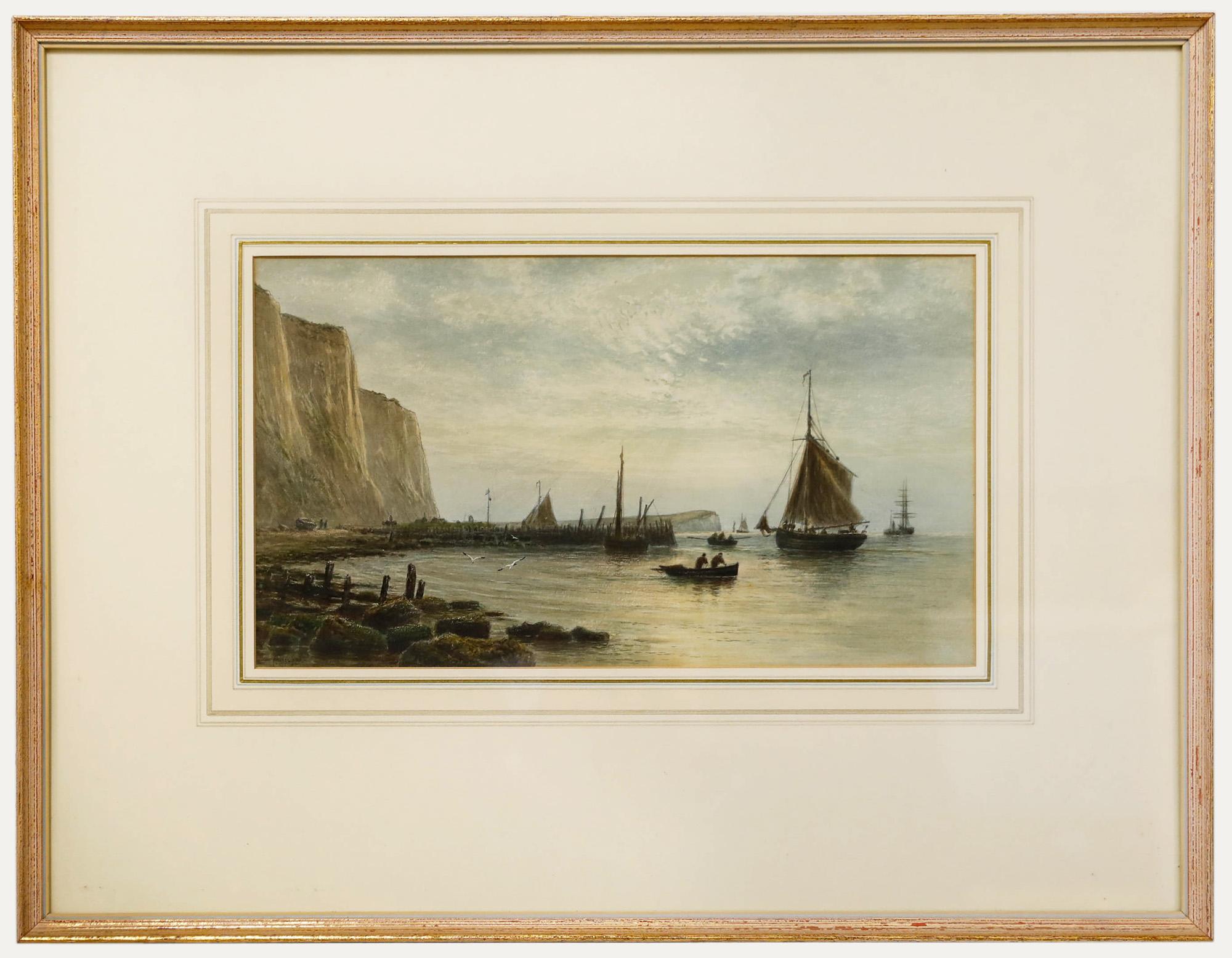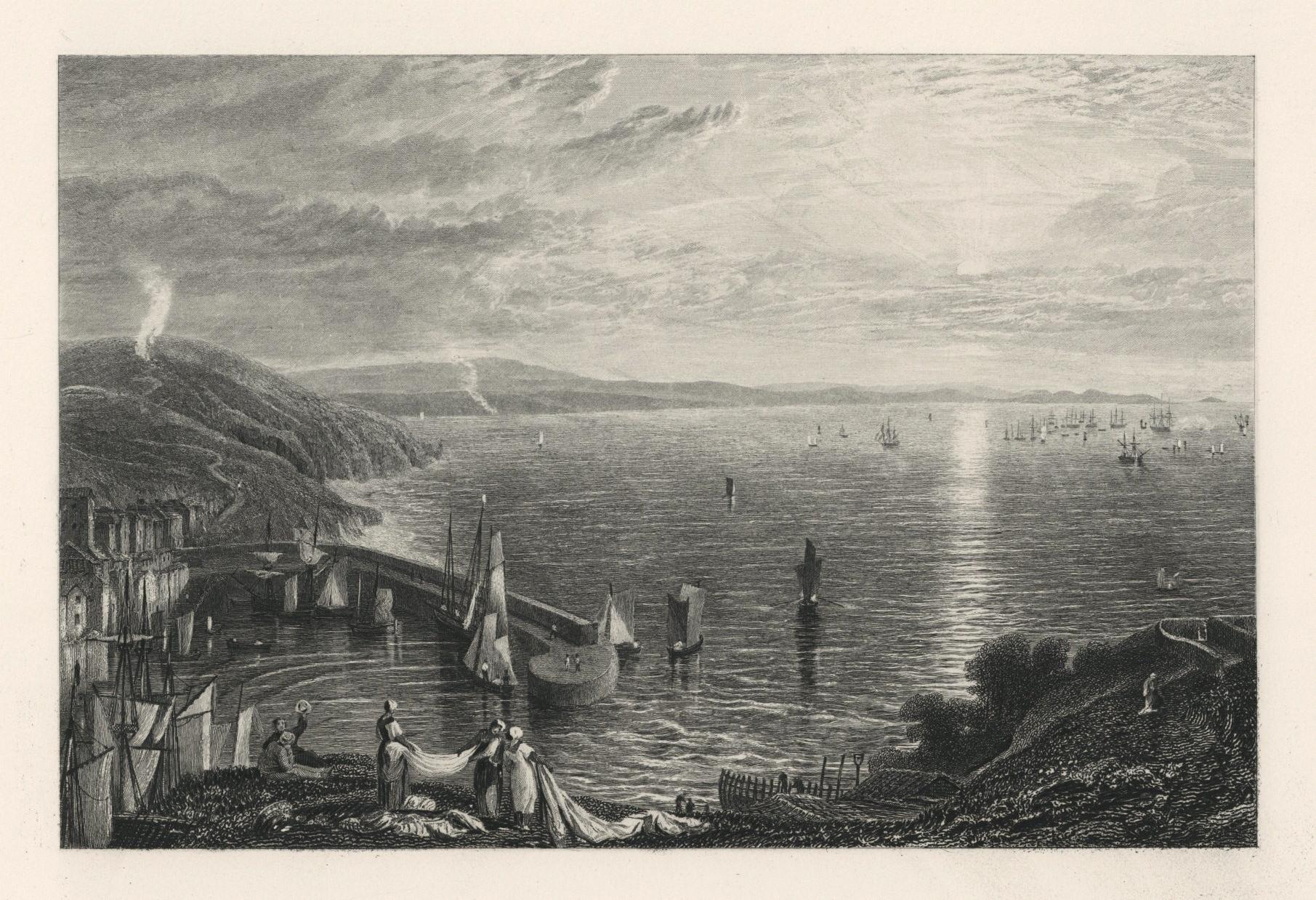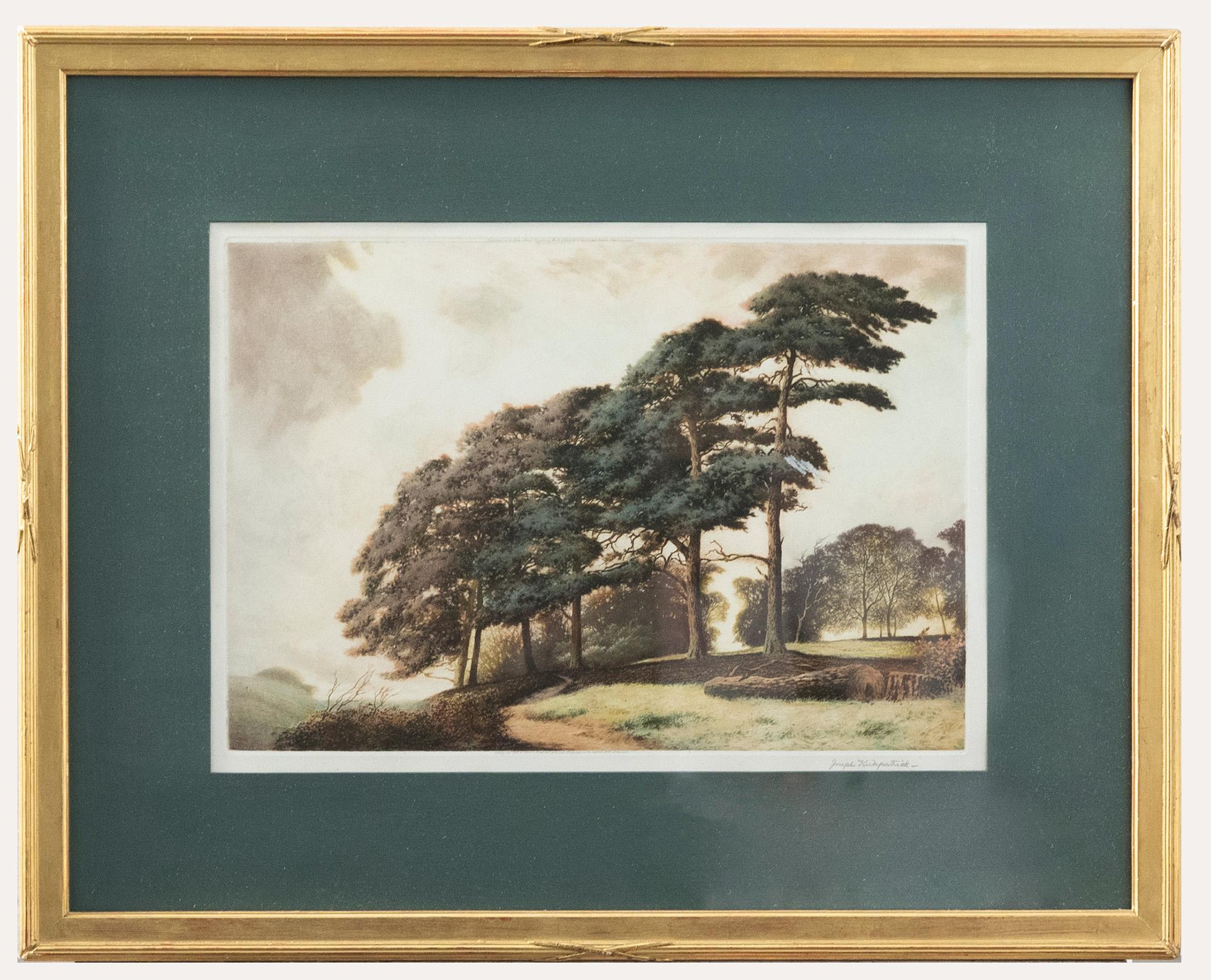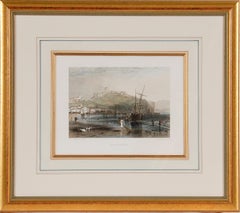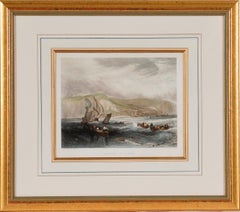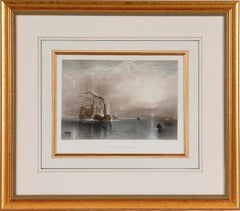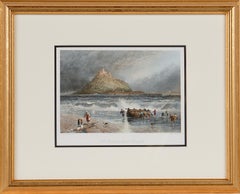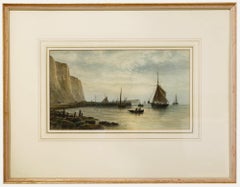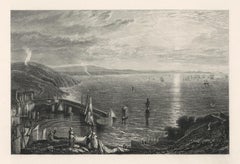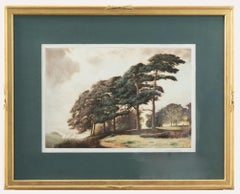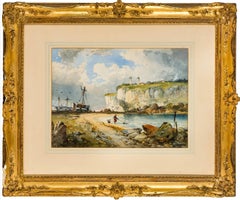Items Similar to A View of Dover, England: A Framed 19th C. Engraving After J. M. W. Turner
Want more images or videos?
Request additional images or videos from the seller
1 of 10
A View of Dover, England: A Framed 19th C. Engraving After J. M. W. Turner1859
1859
$460
$57520% Off
£350.88
£438.6020% Off
€399.76
€499.7020% Off
CA$646.53
CA$808.1720% Off
A$705.35
A$881.6920% Off
CHF 373.48
CHF 466.8520% Off
MX$8,452.12
MX$10,565.1520% Off
NOK 4,756.47
NOK 5,945.5920% Off
SEK 4,349.44
SEK 5,436.8020% Off
DKK 2,984.96
DKK 3,731.2020% Off
About the Item
This beautiful 19th century framed engraving "Dover" by Thomas Lupton is based on an original painting by the renowned British artist J.M.W. Turner, which depicts a panoramic view of the harbor of Dover, a town in southeastern England, that has been an important port for centuries. The engraving captures the dramatic sky and sea that Turner was known for, with billowing clouds and waves crashing against the shore. The town and its famous white cliffs are visible in the background, while ships and boats dot the harbor in the foreground. Several wooden rowboats carrying multiple men are seen in the rough water, with the suggestion of storm clouds in the background. Lupton's engraving, created in the mid-19th century, was a popular way for people to appreciate Turner's artwork before the advent of photography and widespread reproduction techniques.
This colorful 19th century engraving is presented in a gold-colored wood frame and a cream-colored French mat highlighted with a light blue band and thinner mustard and gold-colored bands. There is a gold-colored fillet which further embellishes the engraving. The frame measures 18" high, 20.5" wide and 1" deep. The engraving, frame and mat are in excellent condition.
This engraving is held by several museums and institutions, including: The British Museum, The Metropolitan Museum. The Tate Museum, The Victoria and Albert Museum and The Yale Center for British Art.
Joseph Mallord William (J.M.W.) Turner (1775-1851) was an English painter who is widely considered one of the greatest landscape painters in Western art history. Born in London, he showed a remarkable talent for art from a young age, and studied at the Royal Academy of Arts from the age of 14. He quickly gained recognition for his watercolor landscapes, which were highly innovative and expressive. Turner's style evolved over time, and he became increasingly interested in the effects of light and color. He traveled extensively throughout Europe, and his experiences of the natural world, particularly the sea and the sky, had a profound influence on his art. His paintings are known for their luminosity, atmospheric effects, and dramatic use of color. Despite facing criticism and ridicule from some of his contemporaries, Turner continued to push the boundaries of art, experimenting with new techniques and styles throughout his career. He was a prolific artist, creating thousands of paintings, sketches, and watercolors, and his legacy continues to inspire artists today.
Thomas Goff Lupton (1791-1873) was a prominent British engraver known for his exceptional skills in the field of engraving. Born in Leeds, England, in 1791, Lupton began his apprenticeship as an engraver at the age of 15 under the tutelage of Joseph Rhodes, a local engraver. He went on to study at the Royal Academy Schools in London, where he developed his craft and gained recognition for his work. Lupton's work was highly sought after, and he produced numerous engravings for various publications, including the Illustrated London News and the Penny Magazine. His engravings were often praised for their accuracy and attention to detail, and he became known for his ability to capture the essence of a scene in his work. In addition to his work as an engraver, Lupton was also a successful businessman, and he established his own printing and engraving firm in London in 1826. He continued to produce high-quality engravings throughout his career and was awarded numerous honors for his contributions to the field of engraving, including the title of "Engraver to the Queen." Thomas Goff Lupton died in 1873, leaving behind a legacy of exceptional engraving work that continues to be admired and studied by art enthusiasts and scholars today.
- Creation Year:1859
- Dimensions:Height: 18 in (45.72 cm)Width: 20.5 in (52.07 cm)Depth: 1 in (2.54 cm)
- Medium:
- Movement & Style:
- After:J.M.W. Turner (1775 - 1851, British)
- Period:
- Condition:
- Gallery Location:Alamo, CA
- Reference Number:Seller: # 52041stDibs: LU1173212251142
About the Seller
5.0
Platinum Seller
Premium sellers with a 4.7+ rating and 24-hour response times
Established in 2011
1stDibs seller since 2019
298 sales on 1stDibs
Typical response time: 1 hour
- ShippingRetrieving quote...Shipping from: Alamo, CA
- Return Policy
More From This Seller
View AllA View of Scarborough, England: A Framed 19th C. Engraving After J. M. W. Turner
By J.M.W. Turner
Located in Alamo, CA
This beautiful 19th century framed engraving "Scarborough" by W. Chapman is based on an original painting by the renowned British artist J.M.W. Turner. It was published in London by ...
Category
Mid-19th Century Romantic Landscape Prints
Materials
Engraving
Fishing Off Hastings, England: A Framed 19th C. Engraving After J. M. W. Turner
By J.M.W. Turner
Located in Alamo, CA
This beautiful 19th century framed engraving "Line Fishing Off Hastings" by William Miller is based on an original painting by the renowned British artist J.M.W. Turner, which depicts a scene of fishermen at work off the coast of the town of Hastings in East Sussex, England. The Miller engraving faithfully reproduces Turner's painting, capturing the same atmospheric quality and sense of motion. In the foreground of the image, a group of fishermen are shown in a small boat, with one man using a fishing line to catch fish. In the background, there is a larger ship, along with a view of the town of Hastings and the cliffs beyond. Overall, the Miller engraving "Line Fishing Off Hastings" is a beautiful and detailed representation of Turner's original painting, and provides a glimpse into life in a 19th century fishing community.
This colorful 19th century engraving is presented in a gold-colored wood frame and a cream-colored French mat highlighted with a light blue band and thinner mustard and gold-colored bands. There is a gold-colored fillet which further embellishes the engraving. The frame measures 18" high, 20.5" wide and 1" deep. The engraving, frame and mat are in excellent condition.
Joseph Mallord William (J.M.W.) Turner (1775-1851) was an English painter who is widely considered one of the greatest landscape painters in Western art history. Born in London, he showed a remarkable talent for art from a young age, and studied at the Royal Academy of Arts from the age of 14. He quickly gained recognition for his watercolor landscapes, which were highly innovative and expressive. Turner's style evolved over time, and he became increasingly interested in the effects of light and color. He traveled extensively throughout Europe, and his experiences of the natural world, particularly the sea and the sky, had a profound influence on his art. His paintings are known for their luminosity, atmospheric effects, and dramatic use of color. Despite facing criticism and ridicule from some of his contemporaries, Turner continued to push the boundaries of art, experimenting with new techniques and styles throughout his career. He was a prolific artist, creating thousands of paintings, sketches, and watercolors, and his legacy continues to inspire artists today.
William Miller (1796-1882) was an English engraver and publisher, best known for his work in reproducing the paintings of J.M.W. Turner. Miller was born in Bristol and began his career as an engraver at a young age, working for a variety of publications and artists. In the early 1820s, Miller began working with Turner, engraving many of the artist's most famous works, including "The Fighting Temeraire...
Category
Mid-19th Century Romantic Landscape Prints
Materials
Engraving
$460 Sale Price
20% Off
The Fighting Temeraire: A Framed 19th C. Engraving After J. M. W. Turner
By J.M.W. Turner
Located in Alamo, CA
This beautiful 19th century framed engraving "The Fighting Temeraire" by James Tibbetts Willmore is based on an original painting by the renowned British artist J.M.W. Turner. It was published by James S. Virtue & Co. in London between 1859-1875. It depicts the once mighty British warship the HMS Temeraire being towed away down the river Thames by a much smaller steamboat to a ship-breaking yard to be broken up for scrap. The Temeraire was first launched in 1798 and represented the pinnacle of British ship-building. 180-feet long, constructed of English oak and armed with 98 guns, she was one of the largest warships of the period. The Temeraire became a symbol of British pride and military power that endured throughout the 19th century. The man-of-war served during the French Revolutionary and Napoleonic Wars and was among the last serving ships to have been at the Battle of Trafalgar in 1805. It became one of the many older ships put out of service in the 1830s and 1840s. The once mighty and feared ship symbolizes a once magnificent, but now obsolete, technology. Turner seems to lament her inglorious final journey, being towed by a less magnificent, but modern steam powered tugboat.
The Turner painting was created in 1838 and is now held in the National Gallery in London. Willmore's engraving, created in 1859, captures the dramatic scene with great detail and skill. The image has become an iconic representation of the decline of Britain's naval power and the transition from sail to steam in the 19th century. The sunset in the background is symbolic of the sun going down on British naval power and tradition. The painting conveys profound and diverse themes that are central to the human experience: those of mortality and change, technology and progress, heroism and brutality. The painting demonstrates Turner’s skill as an artist. His ability to produce scenes of great beauty that are dramatic, but are also symbolic, stimulating both thoughtful analysis, as well as emotion. Turner's painting was voted by the British public in a 2005 BBC radio sponsored survey to be the British people's favorite painting of all time. In 2020 it was included on a new British banknote...
Category
Mid-19th Century Romantic Landscape Prints
Materials
Engraving
St. Michael's Mount, Cornwall: A Framed 19th C. Engraving After Myles Foster
By Myles Birket Foster
Located in Alamo, CA
This beautiful 19th century framed hand-colored engraving is entitled "St. Michael's Mount, Cornwall" by J. Saddler after an original painting by the British artist Myles Birket Fost...
Category
Mid-19th Century Romantic Landscape Prints
Materials
Engraving
$460 Sale Price
20% Off
David Roberts' 19th Century Duo-tone Lithograph, "Suez, General View"
By David Roberts
Located in Alamo, CA
"Suez, General View" is a 19th century folio sized tinted duo-tone lithograph, plate 124 from the "The Holy Land, Syria, Idumea, Arabia, Egypt and Nubia" volume of David Roberts’ large folio edition, published in London by F. G. Moon in 1843. The lithographs were prepared by Louis Haghe (1806-1885) from paintings by Roberts. The resultant large folio editions of 'The Holy Land' and 'Egypt & Nubia' are considered the greatest lithographically illustrated works issued in the 19th century. The lithograph depicts the Suez city skyline on a peninsula with boats moored in the bay. Men, dressed in traditional Arab costumes, rest on a hillside In the foreground with their camels, weapons and presumably goods for sale and trade.
This tinted lithograph, which is professionally framed in a decorative gold-colored wood frame with cream-colored double mats. The print is in excellent condition.
There are four additional listings of David Roberts hand colored engravings of Egypt...
Category
1840s Realist Landscape Prints
Materials
Lithograph
Views of London: A Pair of Framed 19th Century Engravings by Havell and Allom
Located in Alamo, CA
This is a pair of framed hand-colored prints, both utilizing engraving and etching techniques, depicting two London architectural landmarks: "The National Gallery, Charing Cross" and "Covent Garden Market" from the Stationers' Almanac, published in London by J. Robins & Sons in the early 19th century. Both of these prints show vibrant London street scenes with markets, carriages, common people as well as the wealthy in the foreground of "Covent Garden Market" and wealthy well dressed people, carriages, a begger, street merchants, as well as uniformed military on horseback in the foreground of "The National Gallery". "The National Gallery, Charing Cross" was created by James Sands from a painting by Thomas Allom (1804-1872), published in 1836. "Covent Garden Market" was created by Frederick James Havell (1801–1840/41) after a painting by William Havell...
Category
Mid-19th Century Naturalistic Landscape Prints
Materials
Engraving, Etching
You May Also Like
Fredrick Miller (fl.1880-1892) - Framed Watercolour, Boats Arriving at Newhaven
Located in Corsham, GB
Original watercolor. Presented in a wash-line mount and 20th-century frame. Signed in the lower right. Labeled on the reverse. On paper.
Category
Late 19th Century Figurative Drawings and Watercolors
Materials
Watercolor
"Torbay from Brixham Quay" engraving
By (After) Joseph Mallord William Turner
Located in Henderson, NV
Medium: engraving (after the painting). Printed on Holland-style wove paper, from the rare large size deluxe portfolio entitled "Picturesque Views on the Southern Coast of England", ...
Category
Early 19th Century Prints and Multiples
Materials
Engraving
Joseph Kirkpatrick (1872-1936) - Framed Aquatint, A Sussex Hilltop
Located in Corsham, GB
An original aquatint in colours by the listed British artist Joseph Kirkpatrick (1872-1936). Elegantly housed in a gilt-effect frame with original a...
Category
Early 20th Century Landscape Prints
Materials
Aquatint
$280 Sale Price
20% Off
A View at Brest - Fine 19th Century France Coastal Landscape Antique Painting
Located in Sevenoaks, GB
A fine 19th century coastal lanscape at Brest in Brittany, France by the imprtant British artist Richard Principal Leitch.
The work is signed lower left and further signed, inscribed and dated 1880 on a label verso. Presented in a swept gilt frame and glazed.
Artist: Richard Principal Leitch (British, 1827-1888)
Title: View at Brest
Medium: Watercolour on paper
Size: 19 x 22 inches (48 x 56 cm) including the frame
Richard Principal Leitch was the son of the royal watercolour tutor William Leighton Leitch, who taught Queen Victoria, her daughters and her daughter-in-law Princess (later Queen) Alexandra for almost twenty years.
In September 1857 he was in Normandy painting...
Category
1880s Landscape Drawings and Watercolors
Materials
Watercolor
"Mount Edgcumbe" engraving
By (After) Joseph Mallord William Turner
Located in Henderson, NV
Medium: engraving (after the painting). Printed on Holland-style wove paper, from the rare large size deluxe portfolio entitled "Picturesque Views on the Southern Coast of England", ...
Category
Early 19th Century Prints and Multiples
Materials
Engraving
H. Turner - Late 19th Century Watercolour, French Fishermen
Located in Corsham, GB
A fine coastal scene with sgraffito depicting fishermen working on a rocky coastline. The tricolore flies on a mast at the centre of the composition. Presented glazed in a white wash...
Category
19th Century Figurative Drawings and Watercolors
Materials
Watercolor
$484 Sale Price
20% Off
More Ways To Browse
Antique Advent
Antique Engravings London
19th Century Engraving Framed
Mid Century Turner
Watanabe Woodcut
Wayne Thiebaud Landscapes
Altman Central Park
Aspen Poster
Aspen Retro Poster
Ben Harman
Callahan Kevin
Christo and Jeanne-Claude On Sale
Christo Pont Neuf
David Hockney Arrival Of Spring
Earle Eyvind
Etchings New England
Giovanni Battista Falda
Harold Altman Central Park
